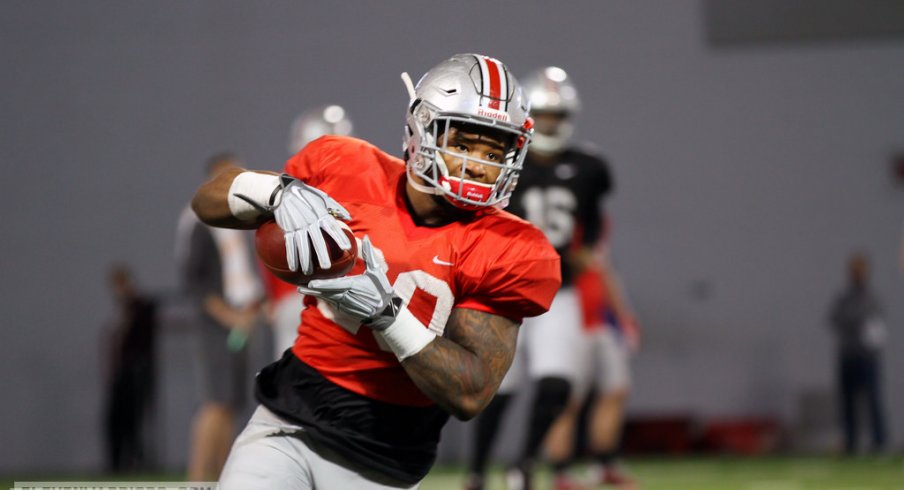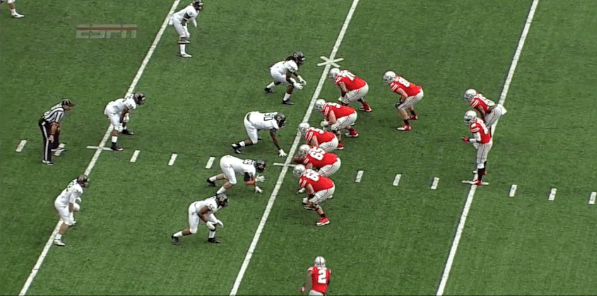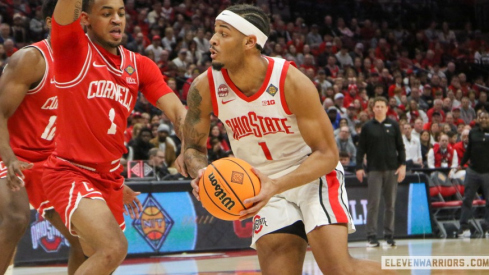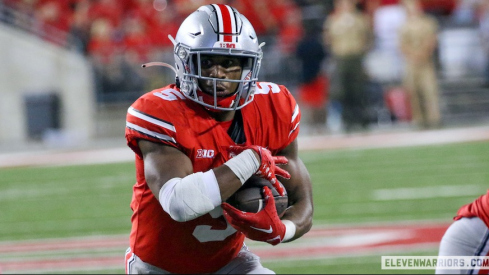Countless former running backs in Bowling Green, Salt Lake City, and Gainesville must feel cheated these days.
While leading the Falcons, Utes, and Gators, Urban Meyer came to be considered a pioneer of 'Spread' offenses, lighting up scoreboards by leaning heavily on the legs of athletic quarterbacks like Tim Tebow and Alex Smith instead of a traditional, workhorse back. Despite a decade full of conference and national titles, though, he failed to ever produce a single 1,000-yard rusher at any point in those three stops.
Upon his hiring in Columbus, many expected the trend to continue. But while Meyer keeps winning, he's flipped the narrative when it comes to his running backs. In his first season as the head man at Ohio State, Carlos Hyde emerged as the centerpiece of Buckeye game plans, rushing for nearly 2,800 yards combined between 2012 and 2013, showing that conventional ball-carriers could succeed in the coach's scheme.
After Hyde moved on the NFL, his successor, Ezekiel Elliott, went on to have one of the most productive careers in program history. After amassing 3,961 rushing yards, only the great Archie Griffin carried the ball further in a Buckeye uniform. But although Elliott didn't bring home the Heisman like Griffin or fellow running back Eddie George, he brought an even more important trophy to Columbus, leading the Buckeyes to a national championship in 2014 and cementing his place among the all-time greats.
As Meyer's 2016 squad prepares for another season with championship hopes, they'll have to find a way to replace Elliott's superior production. For those that simply look at depth charts or recruiting rankings, the obvious answer is Mike Weber, a redshirt freshman from Detroit whose physical appearance is more reminiscent of Hyde.
From a schematic point of view, however, it won't be that easy. Elliott was so versatile as a runner, able to run through tackles and pound away for tough yards inside one play, then use his speed to turn the corner and outrun defenders the next. Meyer had never possessed a weapon of Elliott's caliber at the running back position before, which led to the star ball carrier filling roles that would have otherwise required the services of multiple players in the coach's offenses.
Indeed, throughout his career, Meyer has divided up the responsibilities of attacking inside and out between several players. In his first two years as OSU, Hyde handled the interior carries while quarterback Braxton Miller attacked the edges, a system so successful that both players eclipsed the 1K mark in 2013.

While at Florida, Meyer flipped the roles, asking his quarterback, Tebow, to handle the tough inside carries while entrusting his running backs, and even receivers like Percy Harvin, to handle outside runs. The results were devastating for opposing defenses, who never seemed to have a handle on where to focus in this seemingly devious attack.
But despite all the window dressing, Meyer's running game has always relied on the same core schemes:
- A bruising interior running game with 'Tight Zone' and 'Power-O'
- 'Counter' runs designed to initially look like the above plays before cutting back in the opposite direction
- 'Jet' and 'Buck' sweeps that stretch the defense horizontally
- Adding an 'option' element to all the above runs, giving the offense more potential ball carriers and blockers than there are defenders at the point of attack
How Meyer fills those roles, however, can change from year to year, showing that his system is flexible enough to adjust based on the personnel available. Thanks to Elliott's brilliance and versatility, though, many have assumed that the system works best when a feature back carries the load himself. With the exception of running the option, Elliott was clearly the best option for the three remaining roles, which resulted in 562 carries for the newest Dallas Cowboy over the past two seasons.
Weber appears to be the best fit on the roster as an interior runner, and his name has been atop the depth chart at RB since spring practice. With the dismissal of backup Bri'onte Dunn last month, that place seems set in stone. But although the role of 'inside man' will likely result in the most carries of anyone on the team, given the Buckeyes' reliance on the philosophy, it certainly doesn't mean he'll be the only one carrying the ball this fall.
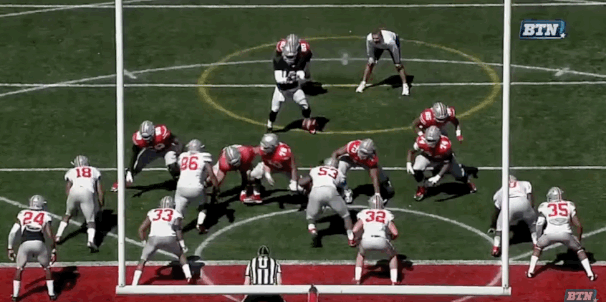
J.T. Barrett's running ability is well-documented and far from a secret to opposing Big Ten coaches, having seen the former conference player-of-the-year gallop for more than 1,600 yards and 22 touchdowns in two years under center. He'll obviously be tasked with running the option and the occasional inside zone, but his value is too great to this team to subject him to 15+ carries per game. Unlike previous years in which the Buckeyes have had a plethora of riches at the QB position, the Buckeyes have no one with any game experience behind Barrett, meaning they'll have to be very conscious of when to use him as a runner.

To complicate things, Barrett is one of only three offensive starters returning this fall. Yet one of the few spots with returning depth is at the 'H' slot position. With many members of the Ohio State offense seeing their first meaningful action this fall, two players that have seen quite a bit of playing time during their careers may finally be ready to take center stage.
Both Curtis Samuel and Dontre Wilson came to Columbus as running backs, who looked to replicate their prodigious high school success at the next level before watching Elliott emerge as an All-American. To make way for their teammate to seek glory, both players eventually made the move to slot receiver before taking yet another backseat, this time to Miller who transitioned from quarterback for the 2015 season.
But although neither player has started more than a handful of games for the Buckeyes, the duo has plenty of experience under their belts. Both have over 100 career touches; a mix of carries, receptions, and kick returns. More importantly, though, the pair possesses a skill set that Weber doesn't, the ability to beat defenders in space, thus making them perfect fits to run counters and sweeps.
Such a recipe for success is certainly not new for Meyer. In fact, his most prolific offense at Florida came in 2009, when Tebow combined with speedsters Jeff Demps and Chris Rainey on a unit that racked up 457 total yards per game in the vaunted SEC.
During that season, Tebow tallied 914 yards on the ground with 14 touchdowns as the main inside presence, while Demps and Rainey combined for over 1,300 yards and 12 trips to the end zone as the outside threats.

Both Demps and Rainey were both regularly on the field together, with one in the backfield while the other lined up in the slot as a receiver.
As Wilson said at yesterday's media day, "I feel like Coach Meyer is doing it because me and (Samuel) I’ll say are the two best athletes on the offensive side, so I feel like he needs us to make a lot of those plays. He doesn’t need us to come off the field so I’m with it.”
Sweeps like this one have long been part of both Samuel's and Wilson's repertoires, often taking a touch pass after coming in motion and looking to turn the corner.
But the duo will also have to show an ability to carry the ball when lined up as a traditional running back, something both Demps and Rainey did with regularity, often as part of an option concept like the Power-Read.
The ability to run concepts like this one, which often sets up the QB for a gashing run through the middle if the defense forces him to keep on the option read, is what makes Meyer's offense so difficult to stop. Luckily, Samuel perfectly fits this role, having spent much of the past two seasons as Elliott's top backup.
Luckily, Samuel is embracing this unique role, noting, “I think that can work pretty well. Whether it’s me and Dontre, or whoever is in the backfield, we’ve both got heart to run through the middle of the line. Defenses can’t just say, ‘Oh, he’s the inside runner and he’s the outside runner.’ We both run hard and we both can do it. We both can run outside as well so I think that’ll work well if it’s me and him or whoever is in the backfield."
While Weber will likely act as the face of the Buckeye running game this fall, the entire quartet of he, Barrett, Wilson, and Samuel will have to step up to fill the gap left behind by Elliott. But while the pressure to replace a legendary player may be great, the challenge isn't impossible.
What made Elliott so great was his incredible ability to fill so many different roles at once, including as a blocker and receiver. Few players can do that, but they also don't usually have to. Football is still a team game and plenty of Meyer's squads, regardless of location, have succeeded with the formula of using multiple faces to populate the core philosophies of his running game.
So while fans may miss seeing a player re-write the record books as Elliott did, they likely won't miss the most important effect of all those records: a dominant running game that powers a championship-contending offense.
